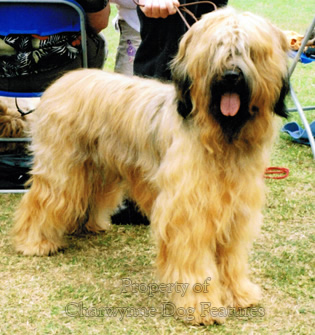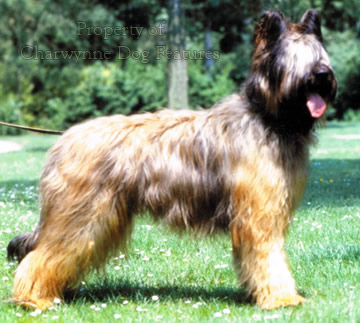908 THE BERGER OF BRIE
THE BERGER OF BRIE
by David Hancock

 - Nos chiens de berger.jpg) Only comparatively recently have we in Britain come to appreciate and then value the herding or herd-protecting breeds of France. But recently, with 12 Pyrenean Sheepdogs (rough-faced), 19 Beaucerons and 126 Briards registered with the Kennel Club in 2012 to reinforce the 105 Pyrenean Mountain Dogs, our acknowledgement of their many agreeable qualities is manifesting itself; all the French herding breeds resemble other European breeds too. The Berger de Brie or Briard is like the Schafpudel of Germany, the Berger de Beauce is similar to our own smooth collie, the Berger de Picardie resembles our long-lost Smithfield Sheepdog, the Berger des Pyrenees looks like the Schapendoes of Holland, the Catalan Sheepdog and our Bearded Collie, by type, as function and climate decided form. Lesser known varieties like the Berger des Pyrenees a face rasee or smooth-faced Pyrenean Sheepdog, the Berger du Langedoc or Farou, the Berger de Bresse, the Berger de Savoie and the Labrit from Les Landes in the south-west indicate the way in which the various areas can produce their own types, rather as the Galway Sheepdog, the Glenwherry Collie, the Welsh Hillman, the Black and Tan Collie and the Old Welsh Grey existed in the British Isles.
Only comparatively recently have we in Britain come to appreciate and then value the herding or herd-protecting breeds of France. But recently, with 12 Pyrenean Sheepdogs (rough-faced), 19 Beaucerons and 126 Briards registered with the Kennel Club in 2012 to reinforce the 105 Pyrenean Mountain Dogs, our acknowledgement of their many agreeable qualities is manifesting itself; all the French herding breeds resemble other European breeds too. The Berger de Brie or Briard is like the Schafpudel of Germany, the Berger de Beauce is similar to our own smooth collie, the Berger de Picardie resembles our long-lost Smithfield Sheepdog, the Berger des Pyrenees looks like the Schapendoes of Holland, the Catalan Sheepdog and our Bearded Collie, by type, as function and climate decided form. Lesser known varieties like the Berger des Pyrenees a face rasee or smooth-faced Pyrenean Sheepdog, the Berger du Langedoc or Farou, the Berger de Bresse, the Berger de Savoie and the Labrit from Les Landes in the south-west indicate the way in which the various areas can produce their own types, rather as the Galway Sheepdog, the Glenwherry Collie, the Welsh Hillman, the Black and Tan Collie and the Old Welsh Grey existed in the British Isles.
 - Nos chiens de berger.jpg)
 - Nos chiens de berger.jpg)

In France their berger de Brie or Briard and their Picardy sheepdog represent their bouvier or drover's dog and their berger de Beauce or Beauceron equates to the German Shepherd Dog. The Briard is reputed to have accompanied Napoleon's armies, (perhaps creating the Armant found in Egypt), driving sheep for his quartermasters. In the more densely farmed areas of central France, the shepherds had to keep close control of their flocks. So they used a team of dogs, one called the 'foot' dog, to collect strays, another called the 'hand' dog, to work close to the shepherd, and a third, known as the 'borders' dog, to patrol the perimeter of the grazing area. This latter task demanded the most training, with this dog covering nearly 100 kilometres each working day.
The Berger de Brie, sometimes called the Bouvier de Brie, has the same shoulder height of the Bouvier des Flandres but not the forequarter bulk. I get depressed when I read again the old fallacy of this breed originating in a Barbet-Beauceron cross, based on appearance presumably but denied entirely by history. The Briard has existed in its own right for as long as the Beauceron and belongs to a type which breeds true all over Europe. Of far greater interest is the observation that this breed-type appears wherever the Celts settled. Celtic dogs have long featured griffon-like coats and the Briard has been prized for the sheer harshness of its coat texture. Some display the Afghan Hound ring-tail and others the setter-type tail; I do hope one of these doesn't become a breed point fad - a low-slung tail of any type is surely less important than essential soundness in the breed. - Nos chiens de berger.jpg)
The most numerous of the French sheepdog breeds, the Briard, has, like many of the multi-talented herding breeds, been used widely, as a police-dog, Red Cross dog, sentry-dog and ammunition-carrier. Dogs like the Briard are alleged to have been utilised by Napoleon to drive livestock during his Egyptian campaign; the Egyptian sheepdog of more modern times, the Armant, being coincidentally very like a Briard. The Marquis de Lafayette brought dogs of this type to North America to work with sheep. The Club Francais du Chien Berger de Brie was not formed however until 1897, despite one of the breed being placed first in the class for sheepdogs at the first French dog show held in Paris over thirty years earlier. In the modern breed I have concern still about their temperament especially excessive shyness, having learned long ago the deceptive and unpredictable nature of this feature. But there seems to be a responsible breed club in Britain looking after the best interests of the breed here. I do have concerns however about the ever-increasing length of coat in the breed - and some worries about the texture of this longer coat. Pastoral dogs, of all breeds, must have weatherproof coats!


Length and texture in a purebred dog's coat are part and parcel of the essential type of that breed. The 1995 Crufts judge in Briards wrote this in the critique: "While I am very aware of the school of thought that the Briard is a working animal and as such should not be over-groomed for the show ring, I have to admit that the spectacle of a full ring of well-groomed Briards, on the green carpet, was an impressive sight." If that kind of thinking prevails in this distinguished breed then within ten years the Briard will win the Afghan Hound classes! A glance at Briards from past times is enough to indicate that the working dogs in this breed did not feature an overlong coat. A survey of specimens depicted in the late 19th and early 20th centuries clearly reveals a shorter more manageable performance-led jacket in the breed. The parent breed society in France is going to have to be vigilant if this long-valued pastoral breed doesn't fall into the grooming zealots' laps and cease to be a working breed forever - a considerable loss.
